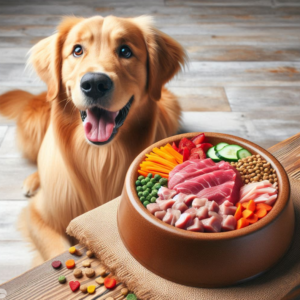You’re committed to providing your furry companion with the best possible nutrition. With the growing popularity of raw dog food diets, you may be wondering if this dietary approach is right for your canine friend. This comprehensive guide will delve into the world of dog food, equipping you with the knowledge and insights to make informed decisions about your dog’s nutritional well-being.

Understanding Dog Food Diets
Raw dog food diets consist of uncooked meat, bones, organs, and vegetables, mirroring the ancestral diet of canines. Proponents of dog food believe this natural diet offers numerous health benefits, including:
-
Improved digestion: Raw food is easier for dogs to digest compared to processed kibble, leading to better nutrient absorption and reduced stool odor.
-
Stronger teeth and bones: Raw bones provide a natural way for dogs to clean their teeth and strengthen their jaw muscles.
-
Shinier coats and healthier skin: A raw food diet is often associated with shinier coats, healthier skin, and reduced allergies.
-
Increased energy levels: Many raw feeders report that their dogs have more energy and vitality after switching to a raw diet.
Types of Raw Dog Food Diets

There are three main types of raw dog food diets:
-
Premade Raw: Premade raw food diets are frozen or refrigerated meals that are already balanced and portioned, making them a convenient option for busy pet parents.
-
DIY Raw: DIY raw food diets involve preparing meals from scratch using fresh, whole ingredients. This approach offers more control over the ingredients and can be more cost-effective.
-
Whole Prey: Whole prey feeding involves feeding your dog whole carcasses, such as rabbits or chickens. This method mimics the way dogs would eat in the wild, providing a complete and balanced diet.
Considerations Before Switching to Dog Food
Before transitioning your dog to a raw food diet, carefully consider the following factors:
-
Your dog’s health: Consult with your veterinarian to ensure your dog is healthy enough for a raw food diet. Puppies, pregnant or lactating dogs, and dogs with certain health conditions may require special considerations.
-
Your lifestyle: Raw food diets require more preparation and handling compared to kibble. Assess your lifestyle and ability to commit to the storage, handling, and preparation of raw food.
-
The cost: Raw food diets can be more expensive than kibble, depending on the ingredients and preparation method.
Making the Switch to Raw Food

If you decide to switch your dog to a raw food diet, it’s crucial to do so gradually to avoid digestive upset. Start by introducing small amounts of raw food into your dog’s current diet, gradually increasing the proportion of raw food over a week or two. Monitor your dog’s stool and overall health during the transition.
Choosing the Right Raw Food
Whether you choose premade raw, DIY raw, or whole prey, selecting high-quality ingredients is essential. Look for raw food sources that are free from antibiotics, hormones, and artificial additives. Ensure the meat is sourced from reputable suppliers and handled safely to minimize the risk of bacterial contamination.
Balancing a Raw Dog Food Diet
A balanced raw dog food diet should include a variety of meat, bones, organs, and vegetables. While some resources provide specific ratios, it’s generally recommended that 60-70% of the diet consist of muscle meat, 10-20% be bones, 10-20% be organs, and the remaining 10-20% be fruits and vegetables.
Supplements for Raw Dog Food Diets

Some dogs may require additional supplements on a raw food diet, such as calcium, vitamin D, and essential fatty acids. Consult with your veterinarian to determine if your dog needs any supplements and the appropriate dosage.
Handling and Storage of Raw Dog Food
Proper handling and storage of raw dog food are crucial to prevent bacterial contamination. Thaw frozen raw food in the refrigerator and use it within a few days. Wash your hands thoroughly after handling raw meat and keep raw food separate from other food items.
Monitoring Your Dog’s Health on a Raw Dog Food Diet

Regularly monitor your dog’s stool, weight, and overall health while they are on a raw food diet. Schedule checkups with your veterinarian to ensure your dog is receiving adequate nutrition and to address any potential health concerns.
Conclusion
Dog food diets can offer numerous health benefits for dogs, but it’s important to approach this dietary change with careful consideration and preparation. By understanding the different types of raw food diets, evaluating your dog’s needs and lifestyle, making a gradual transition, choosing high-quality ingredients, and ensuring proper handling




